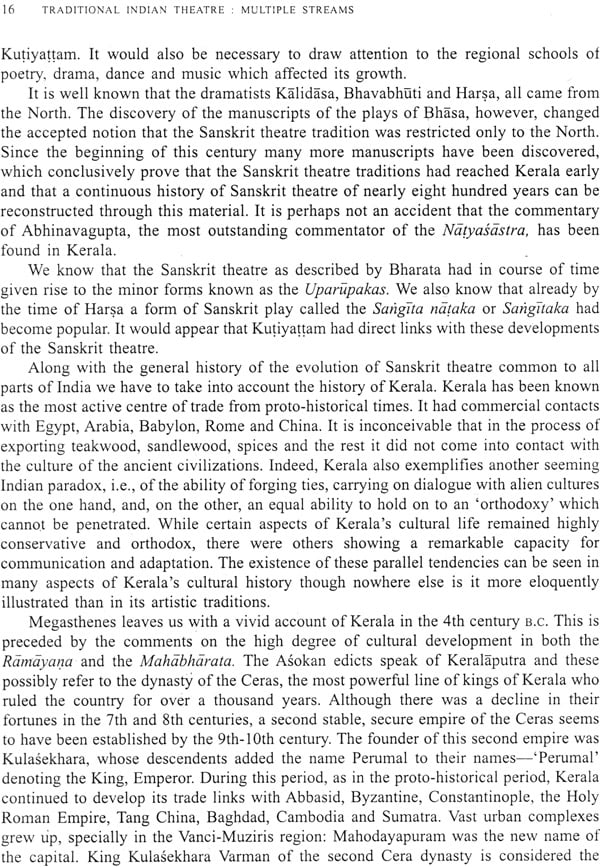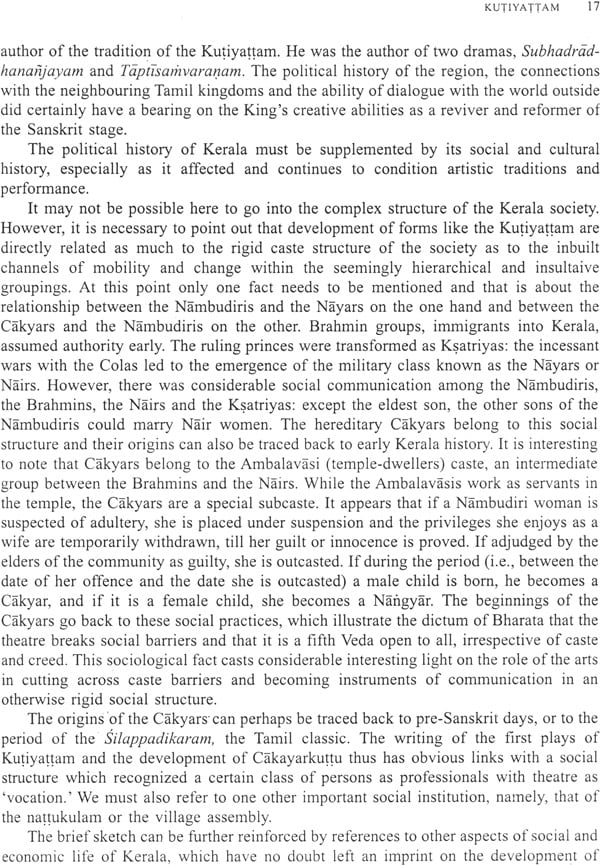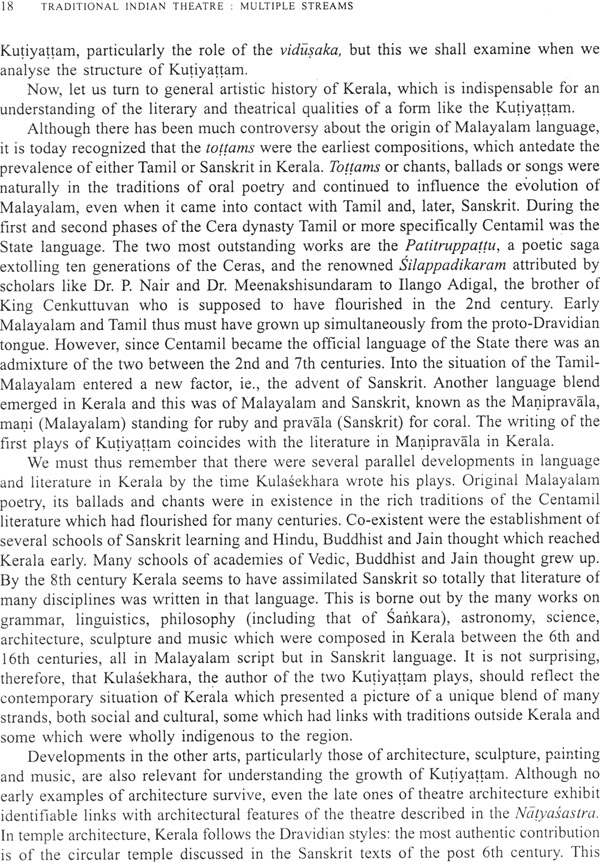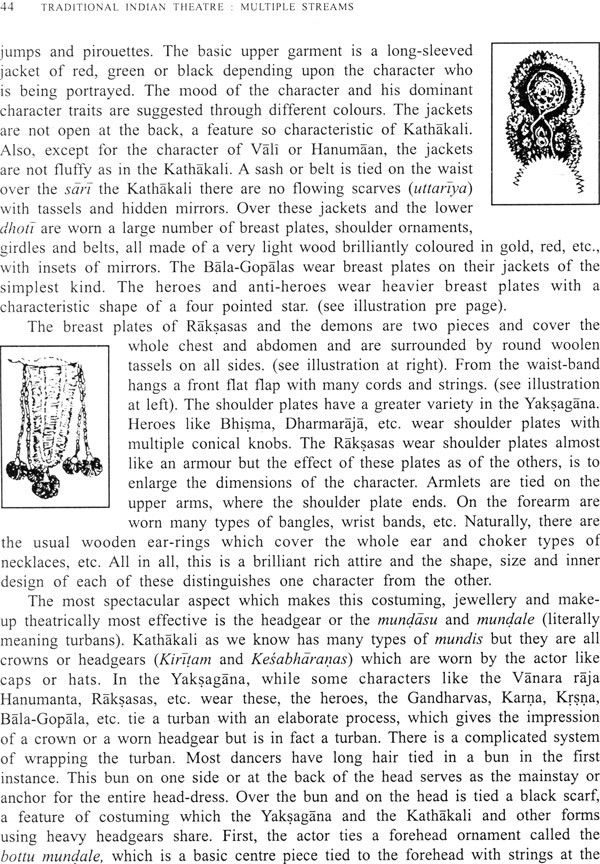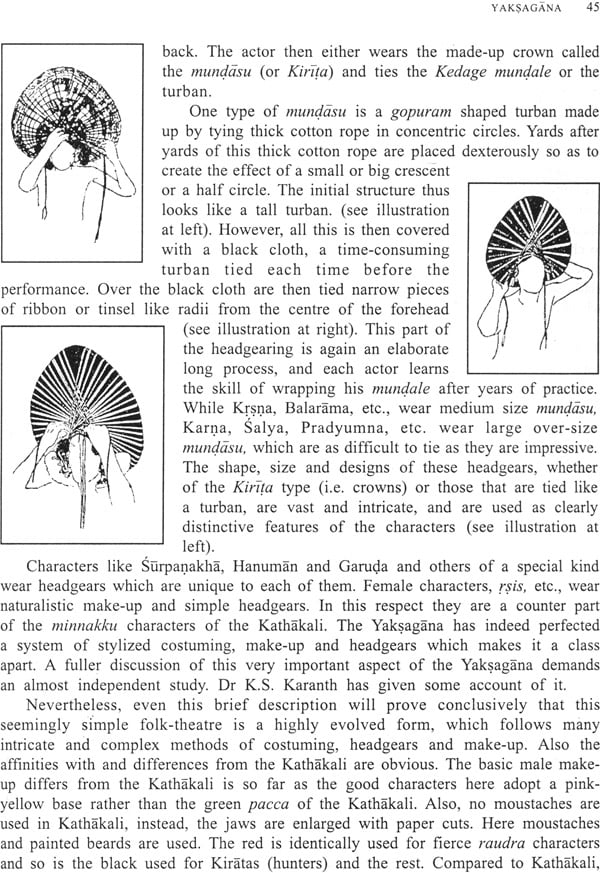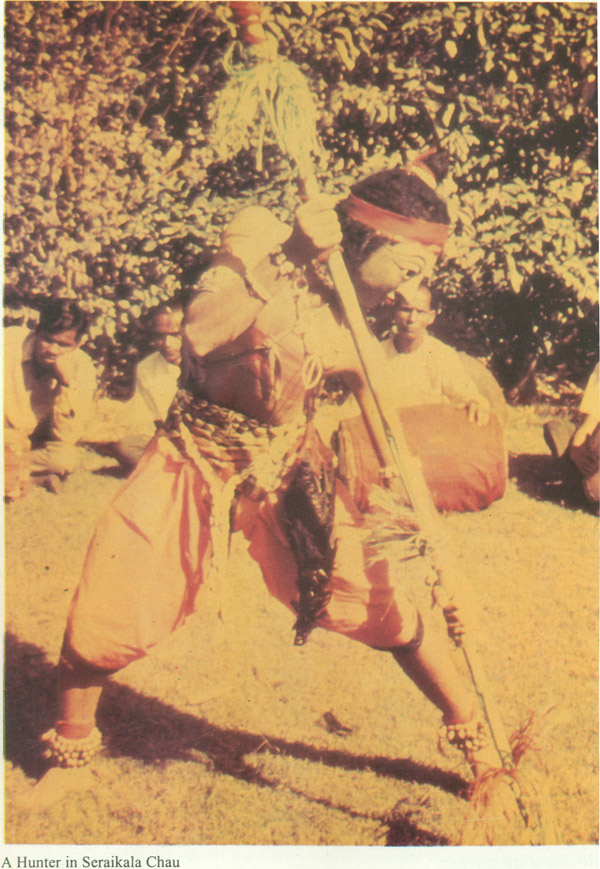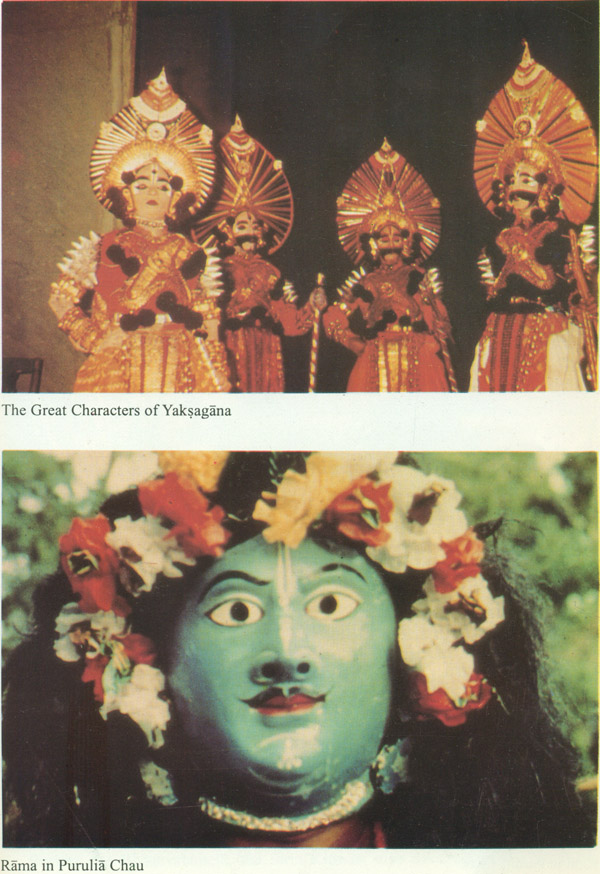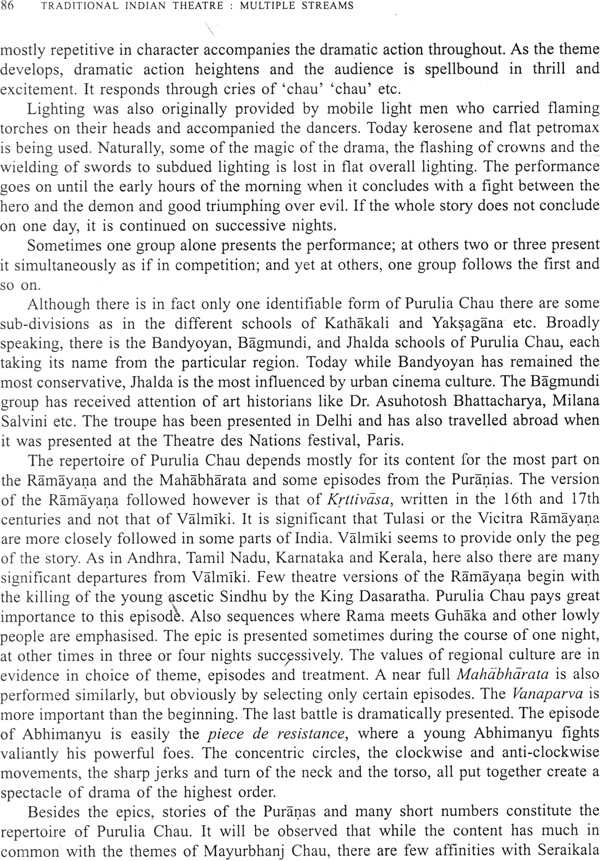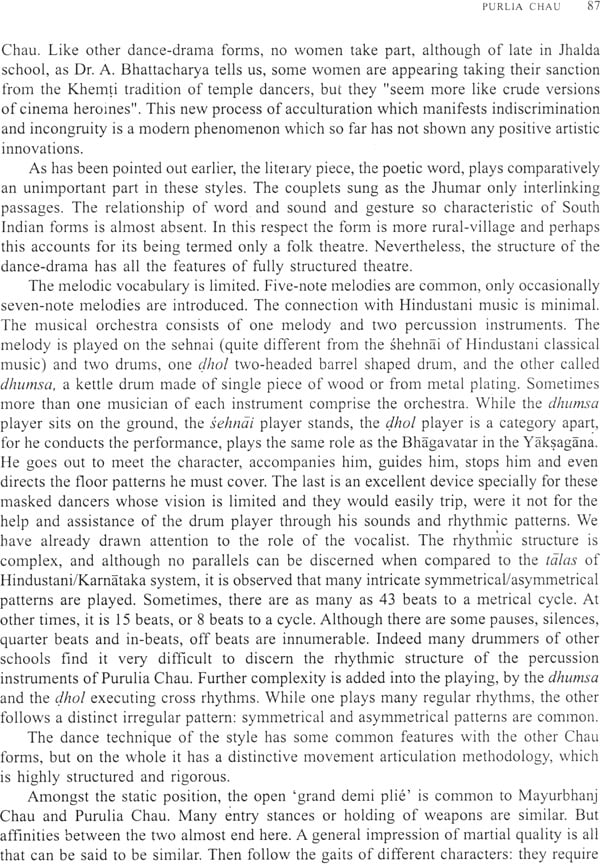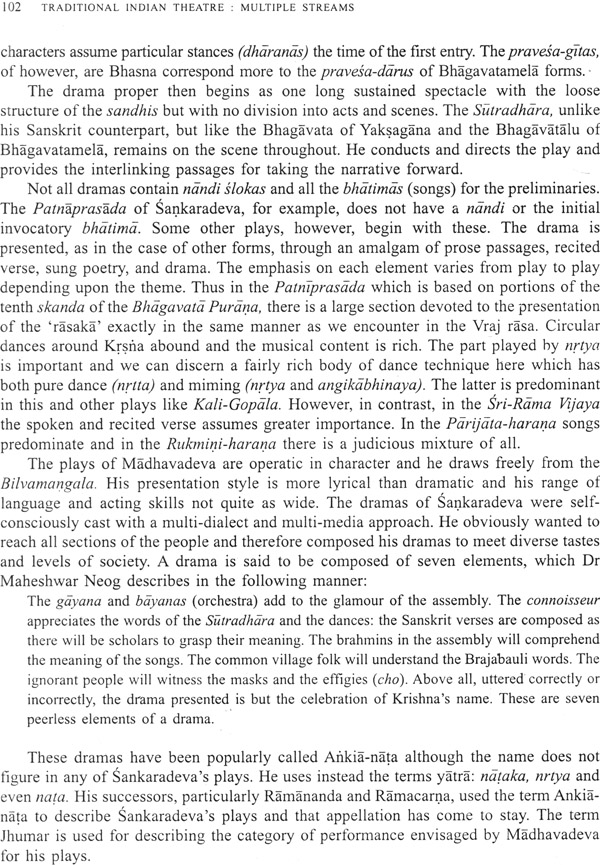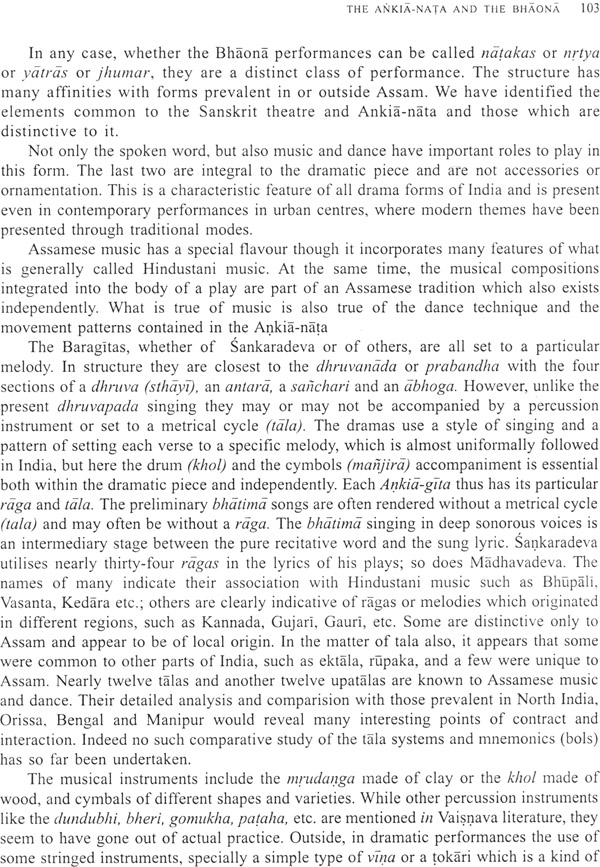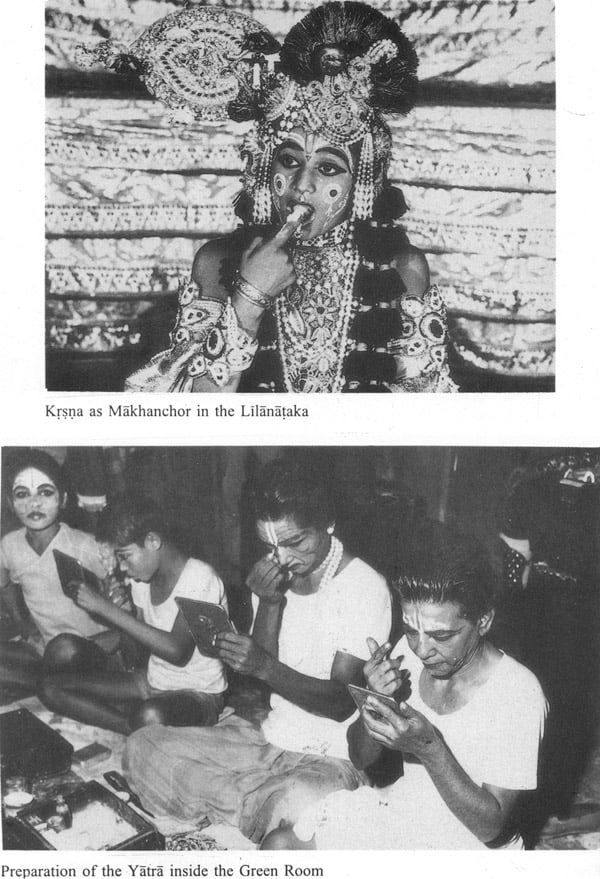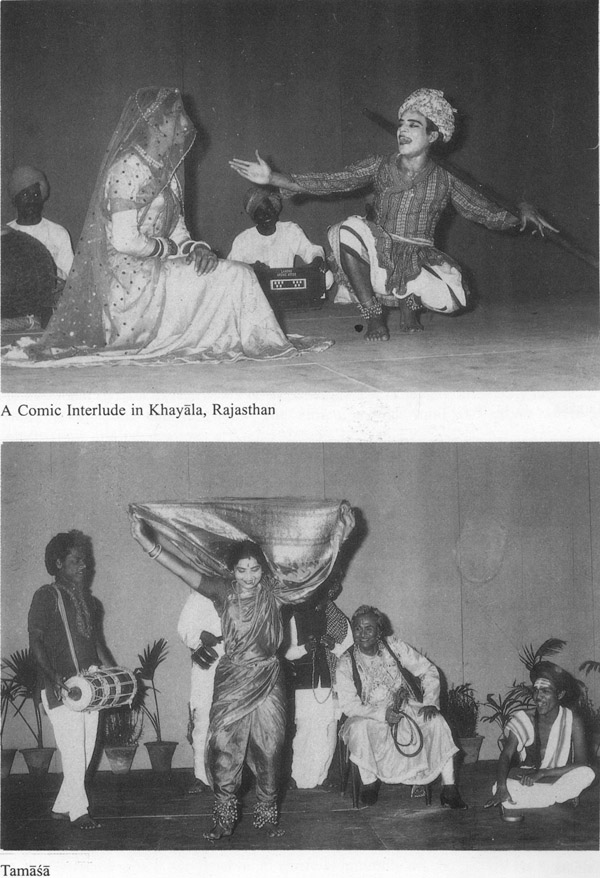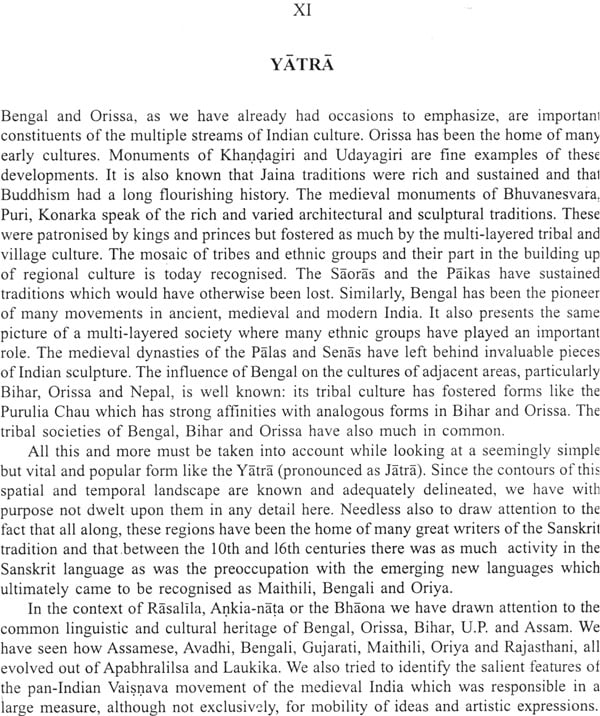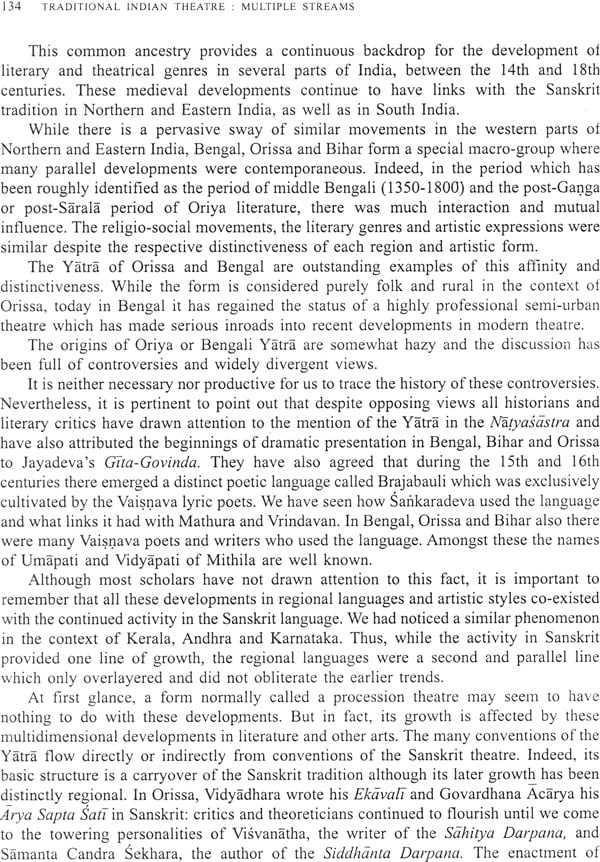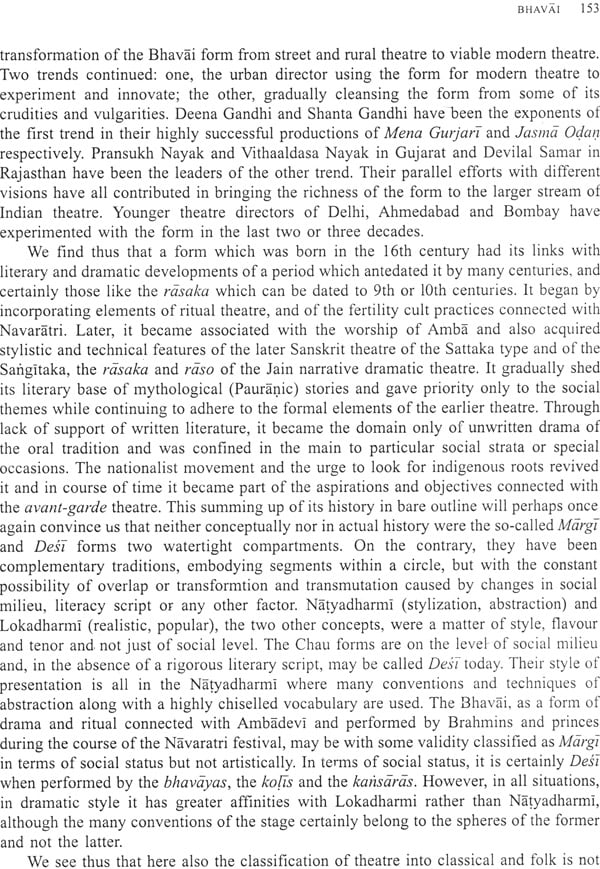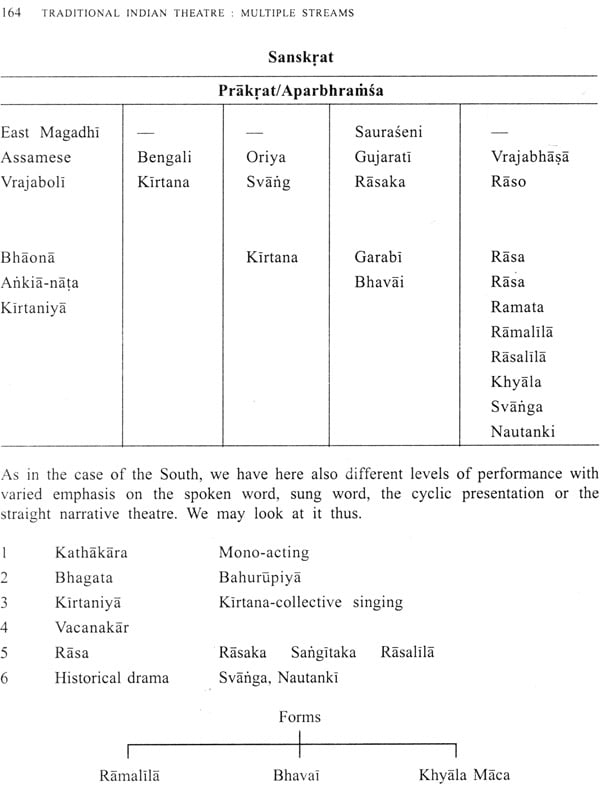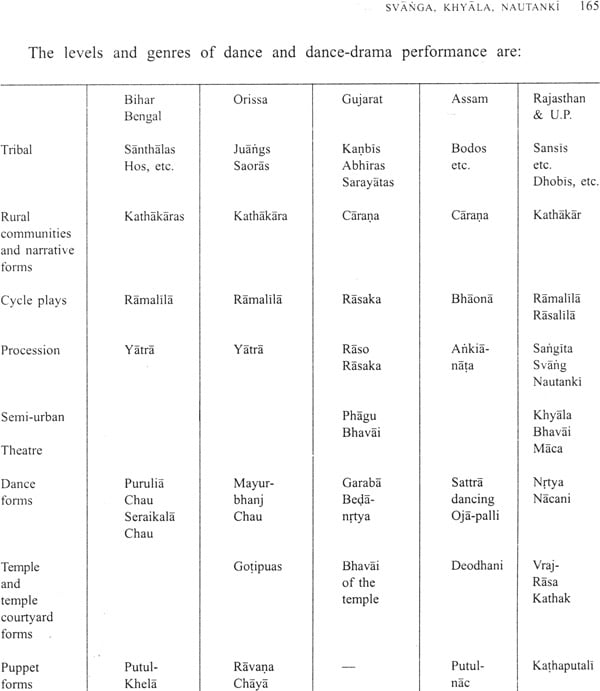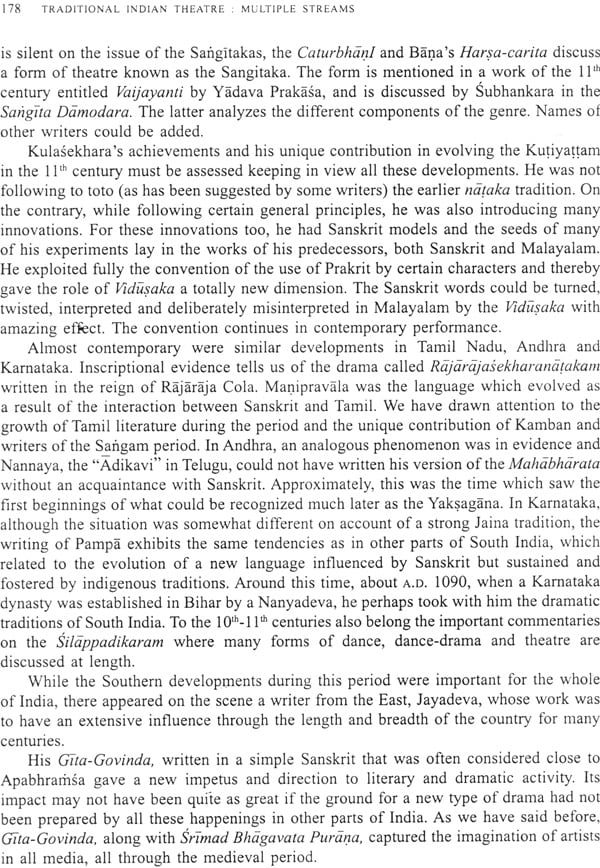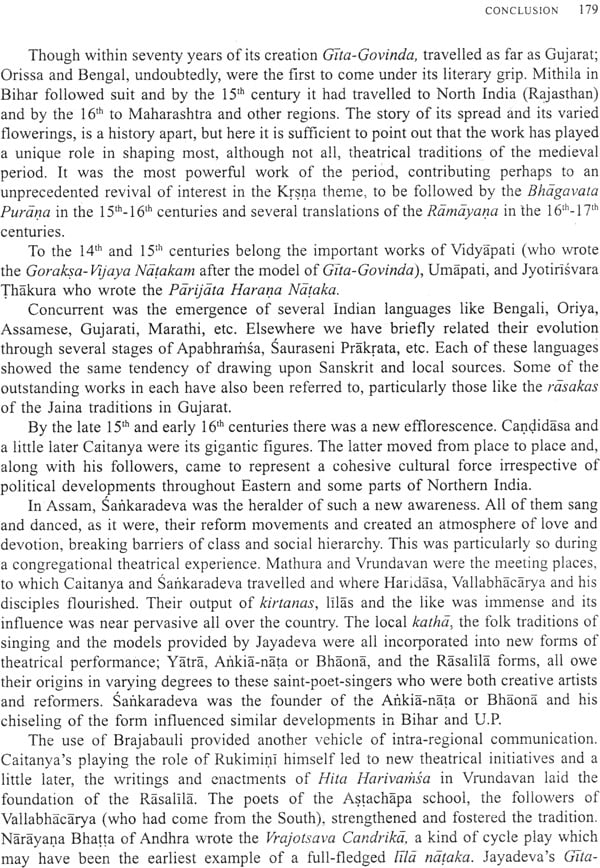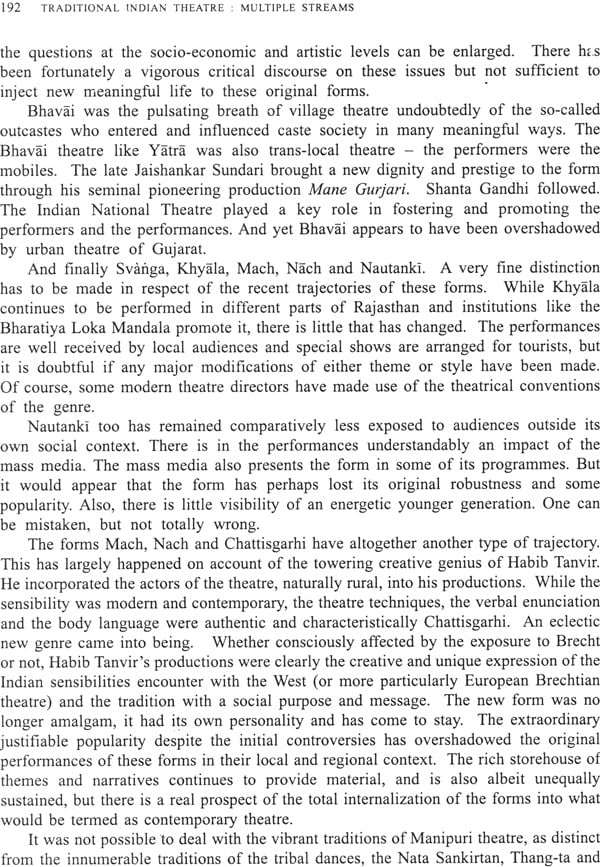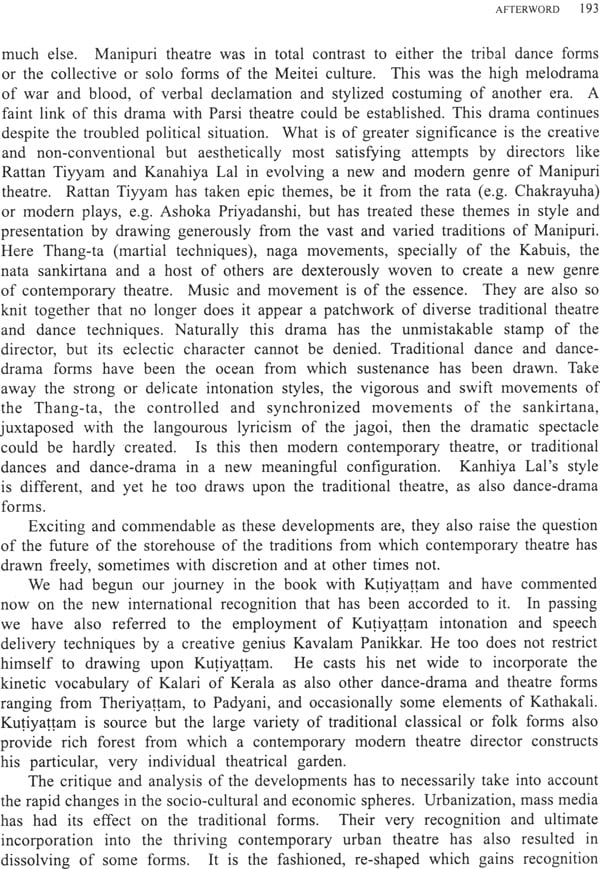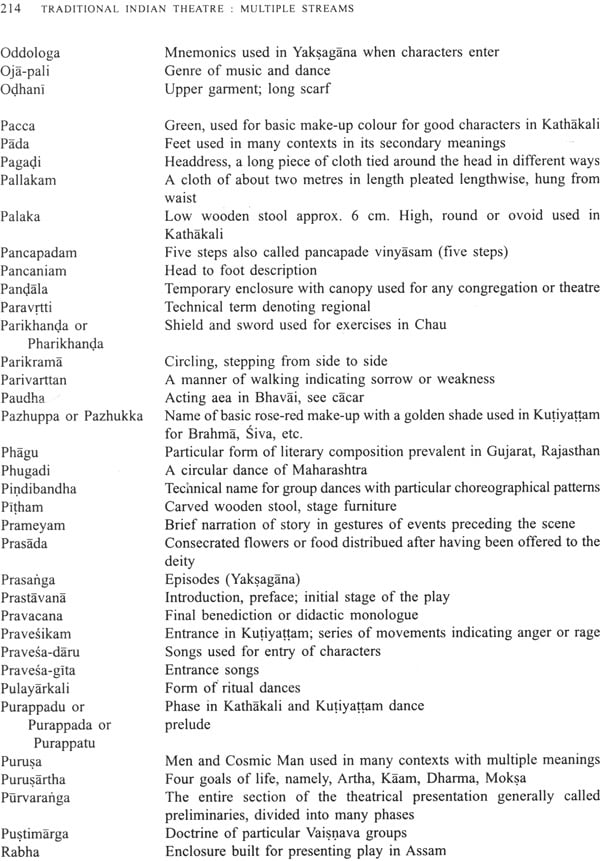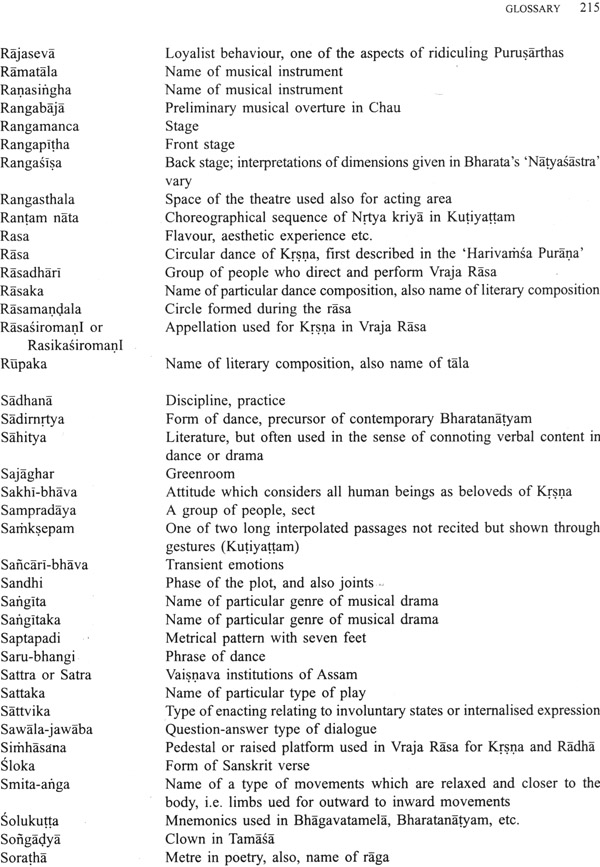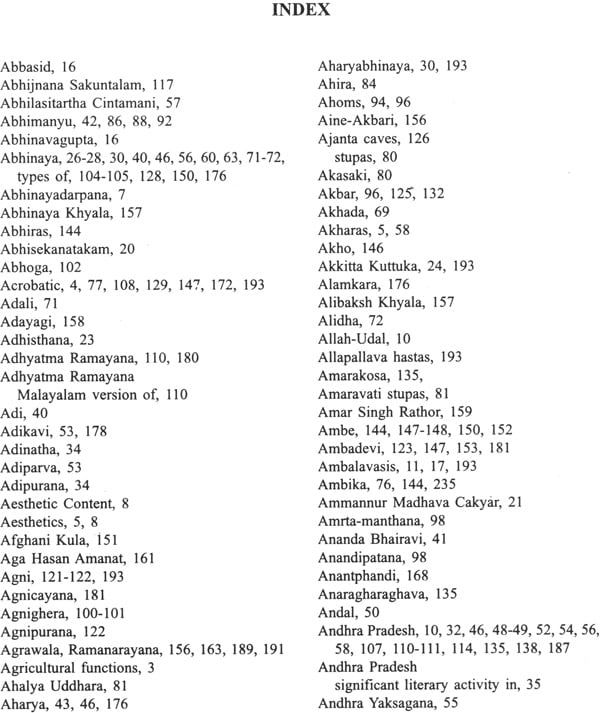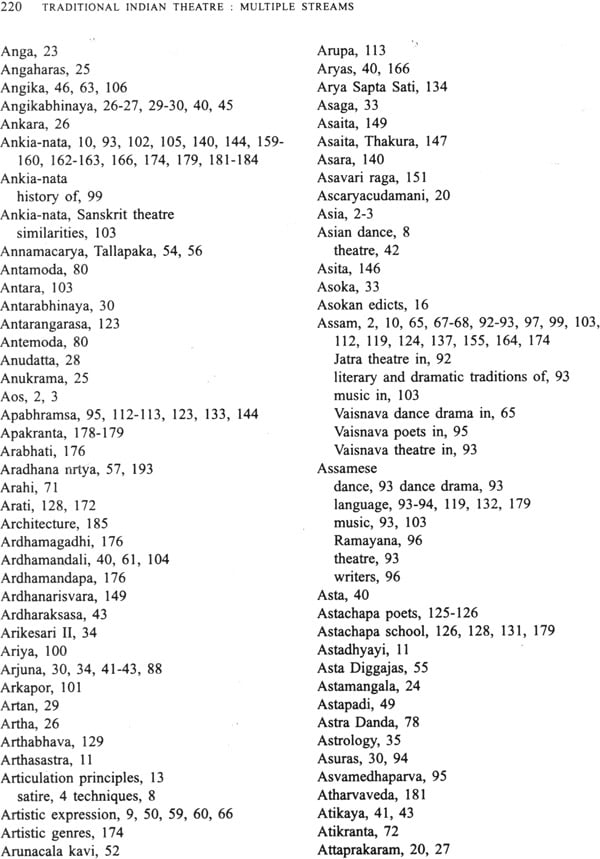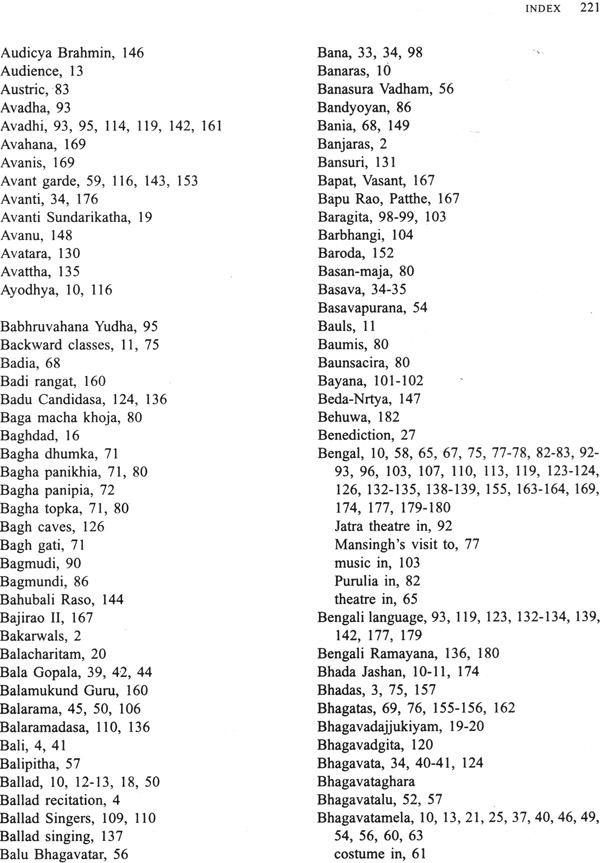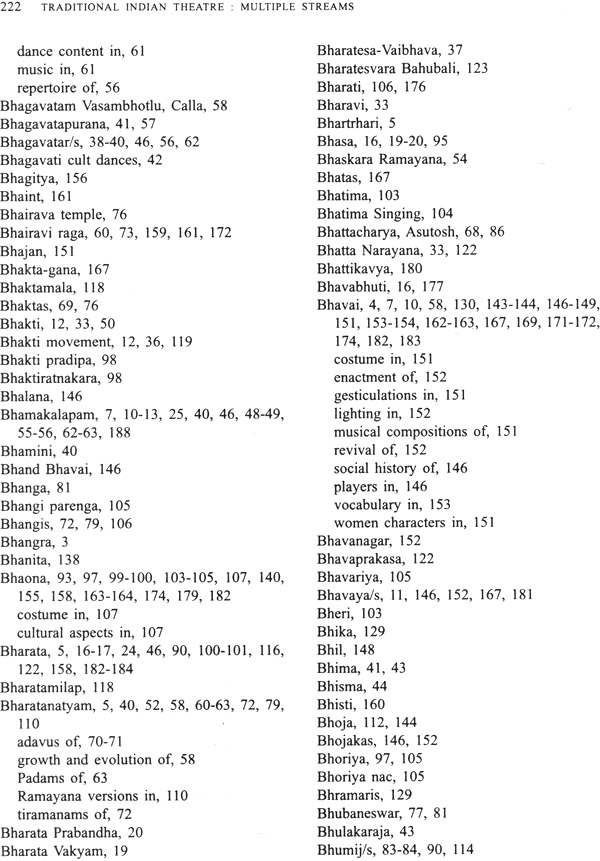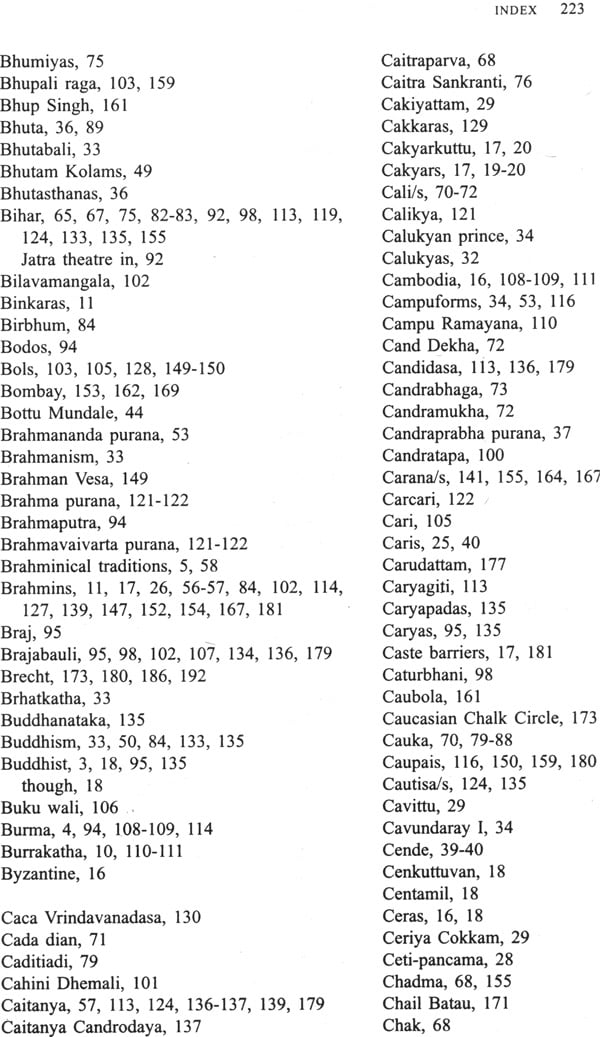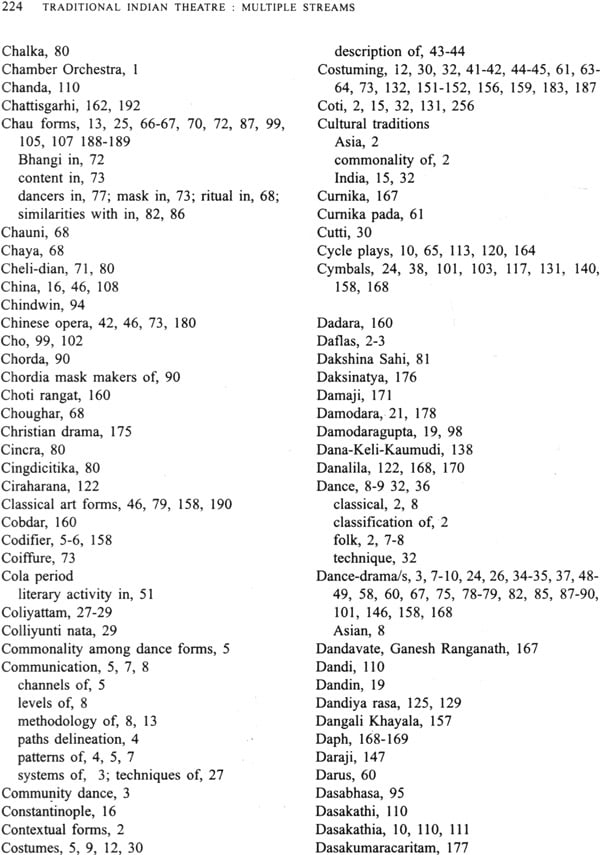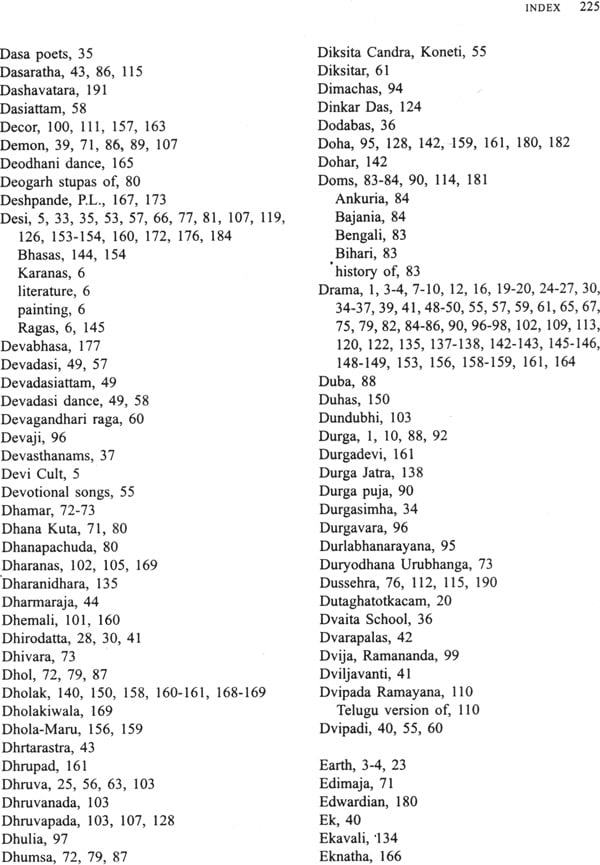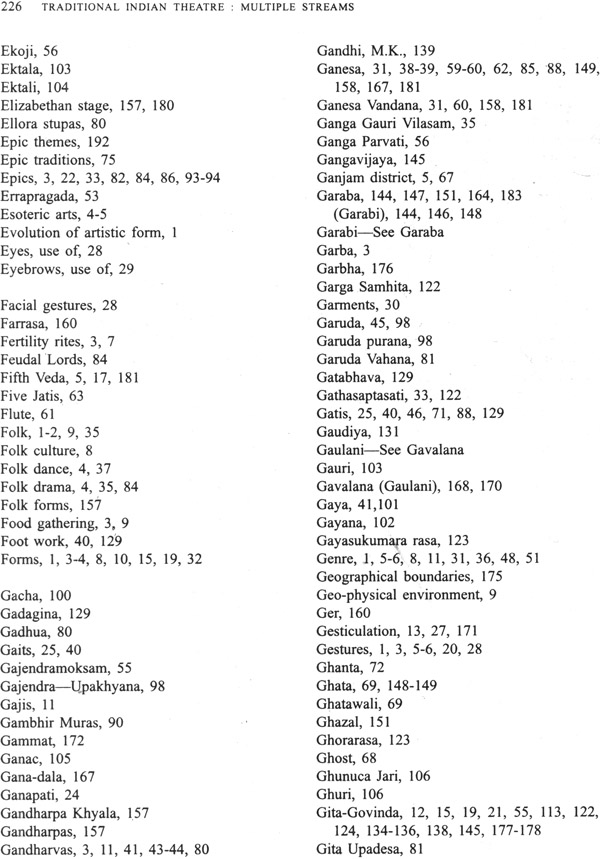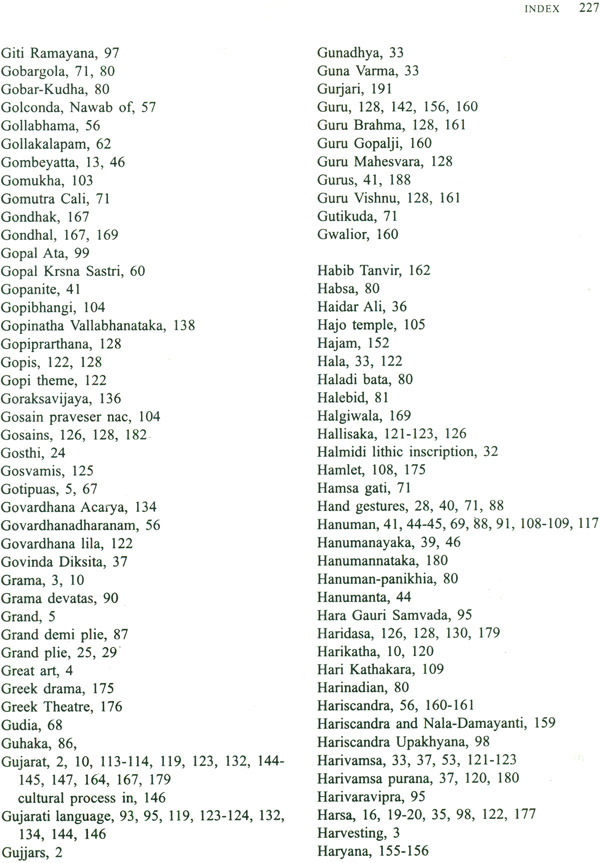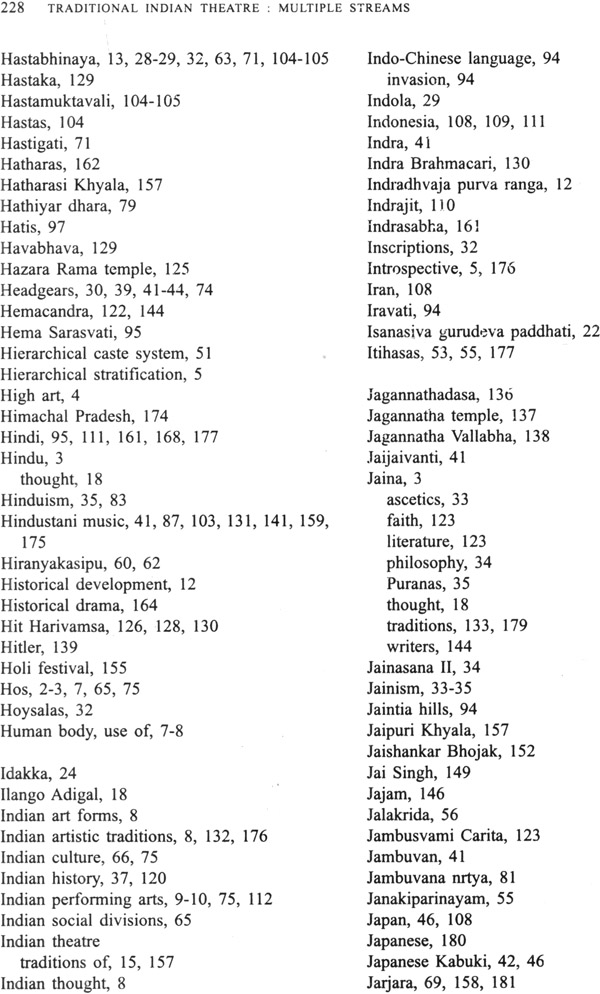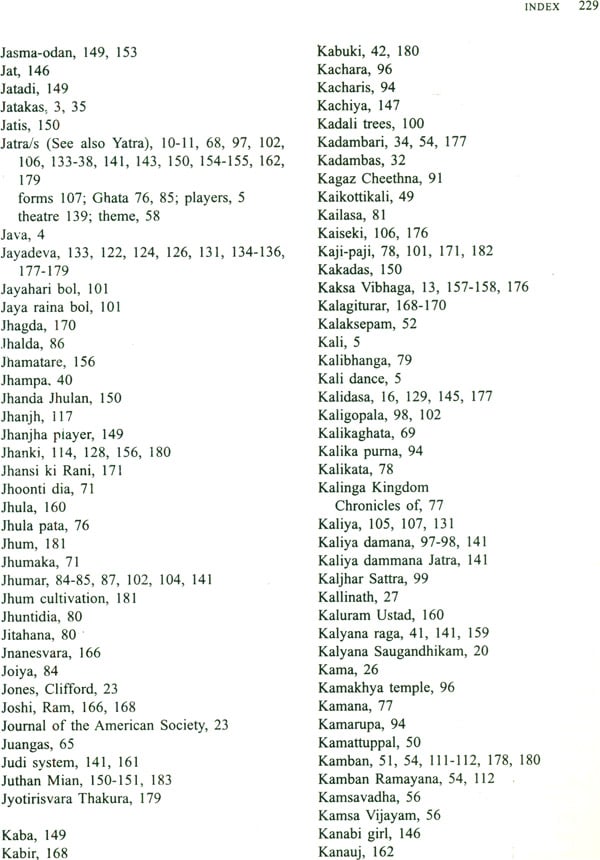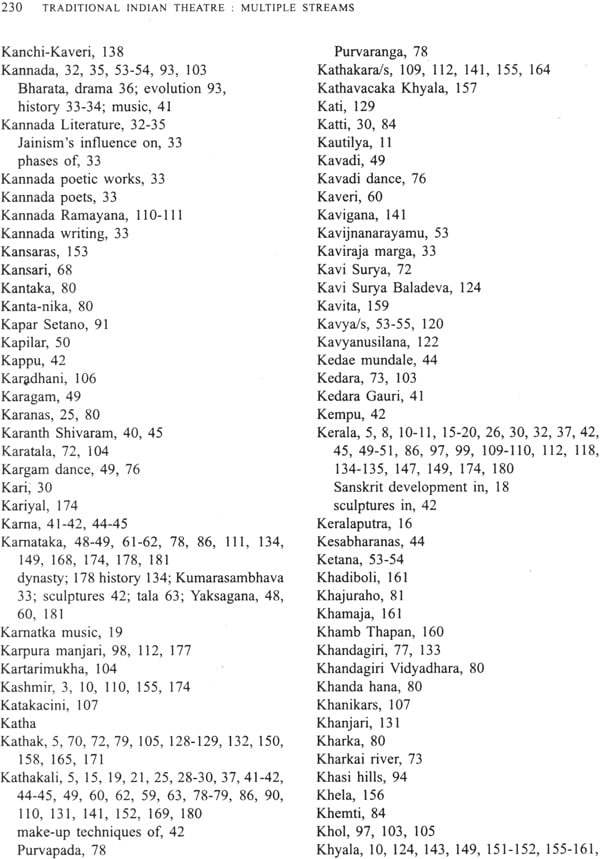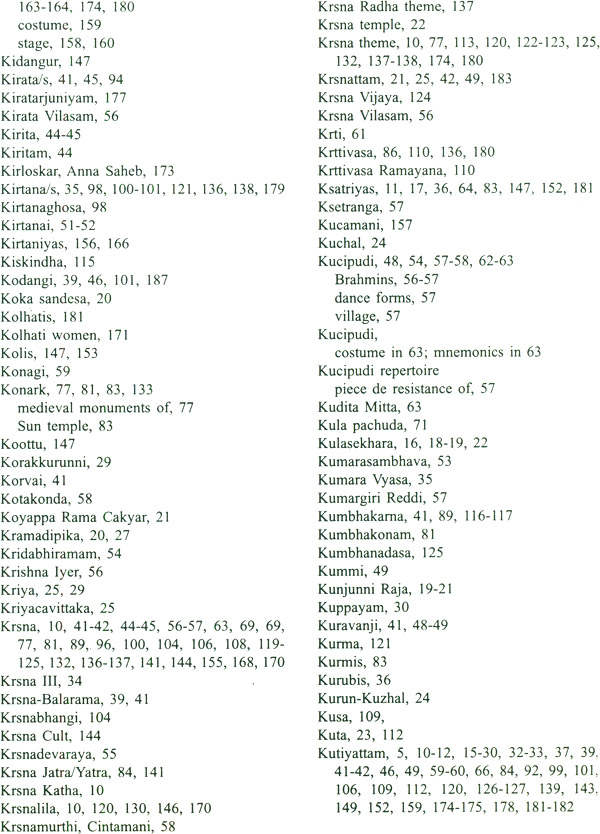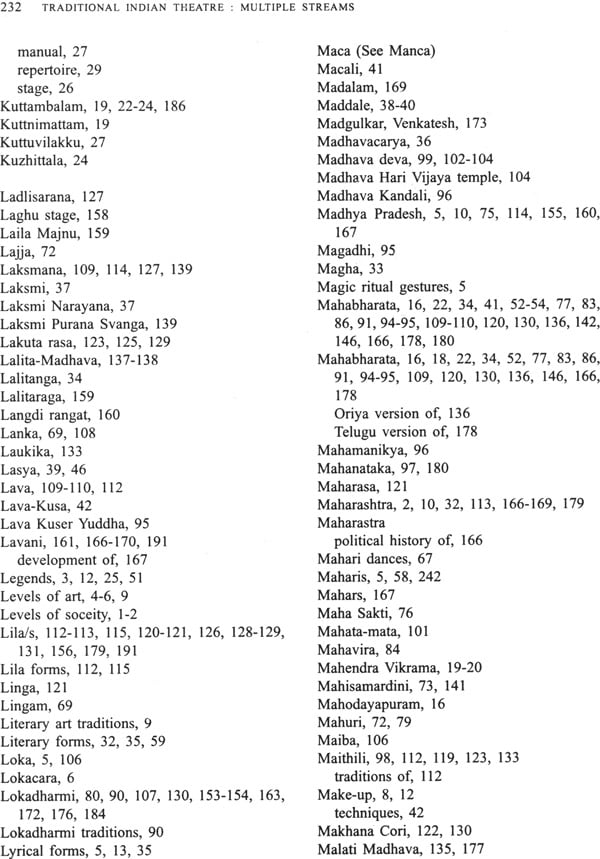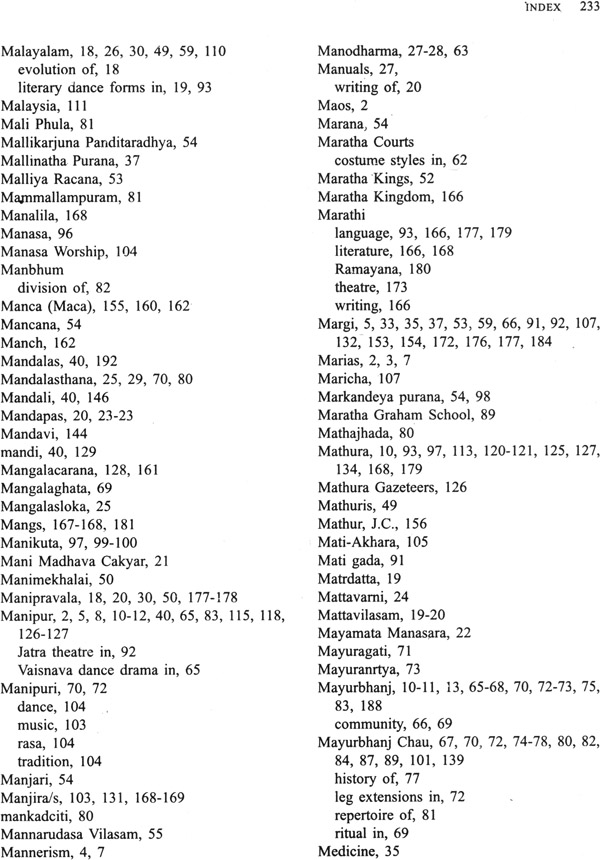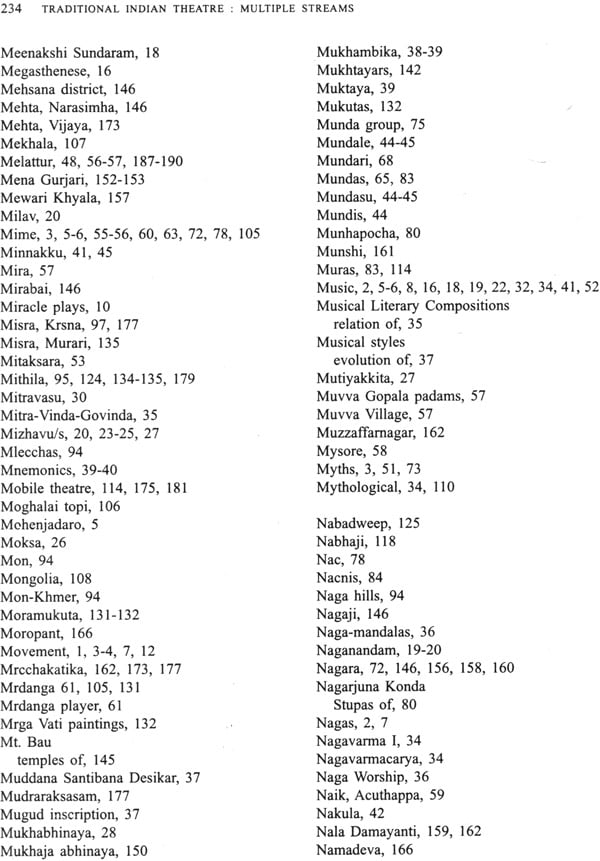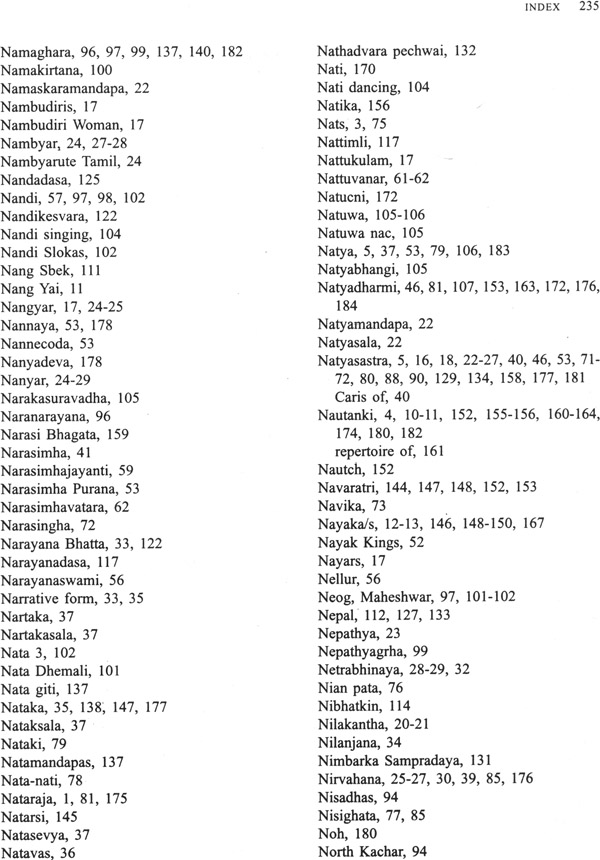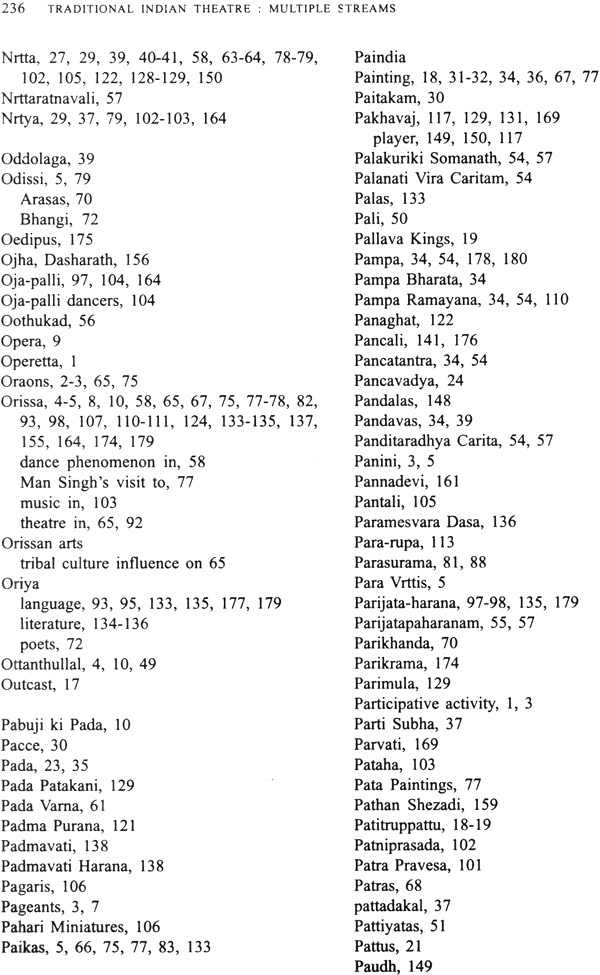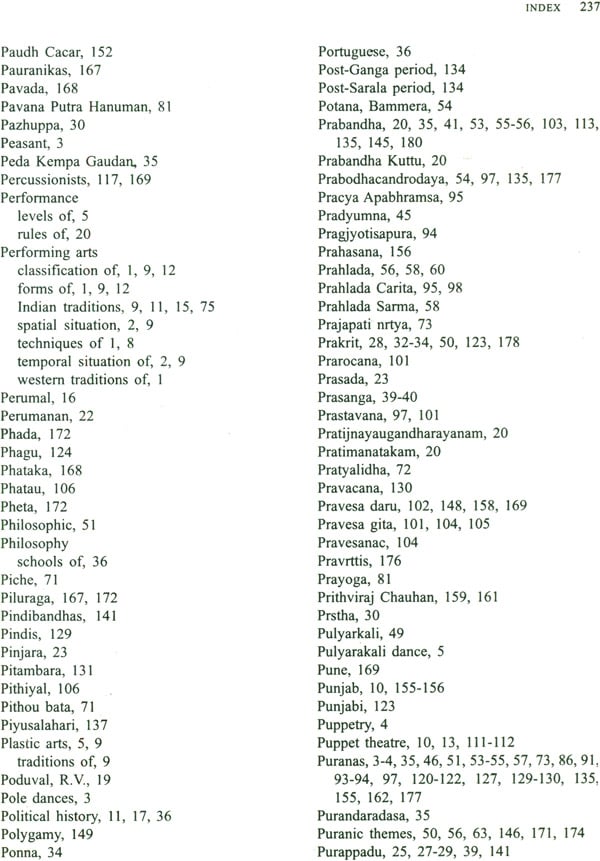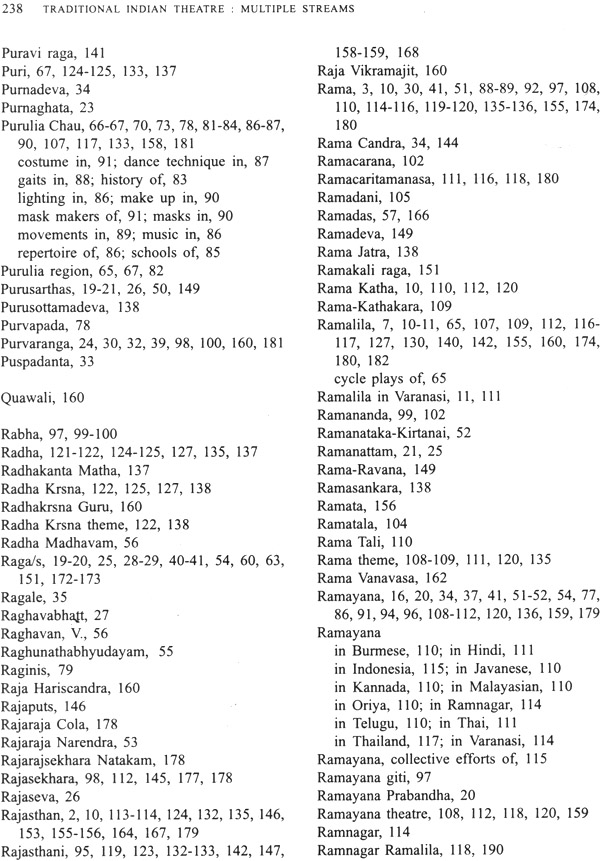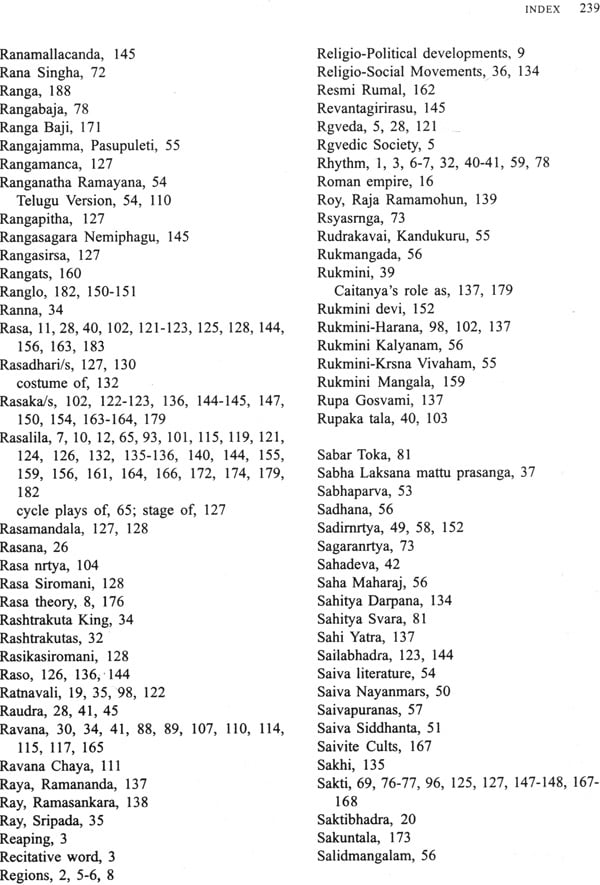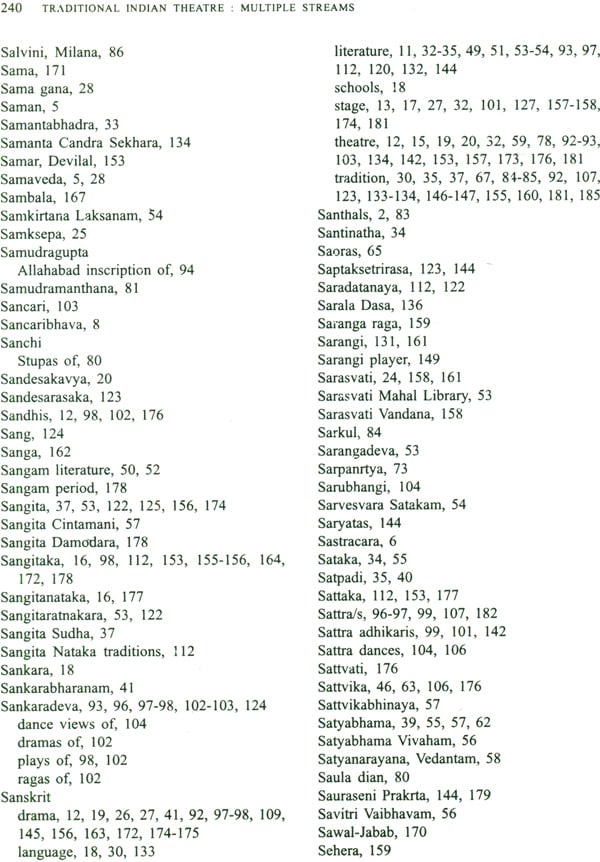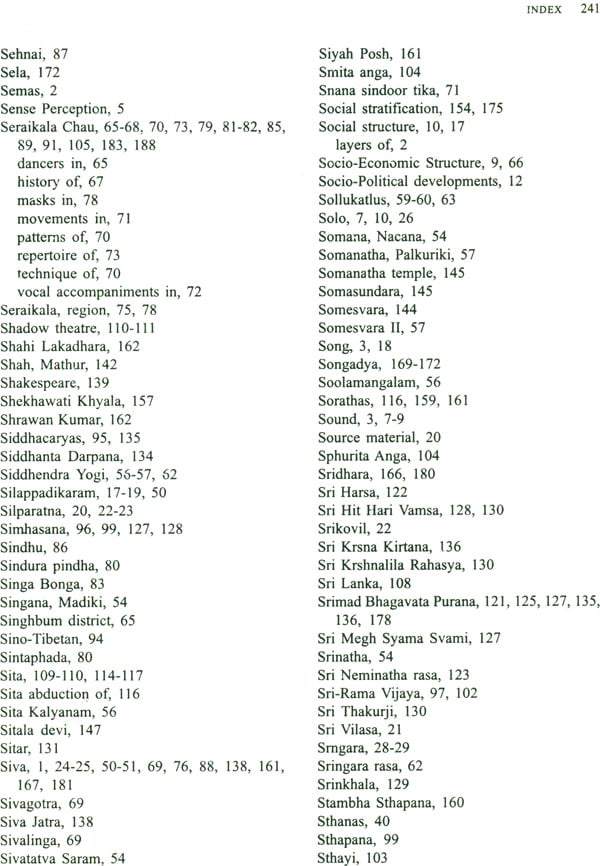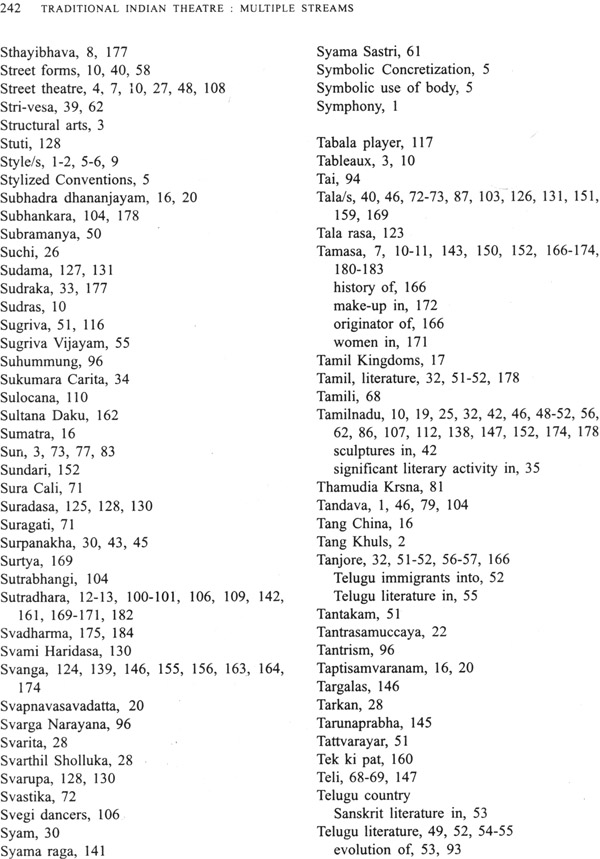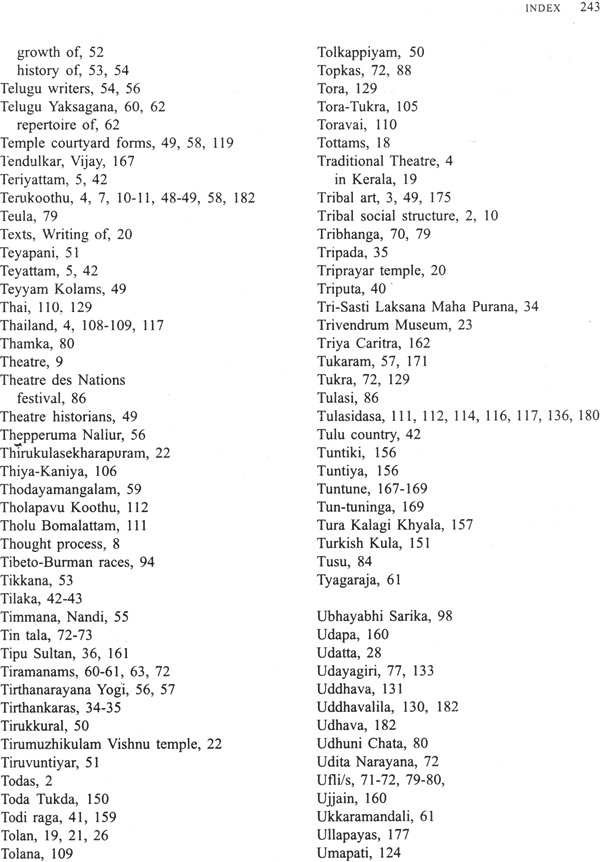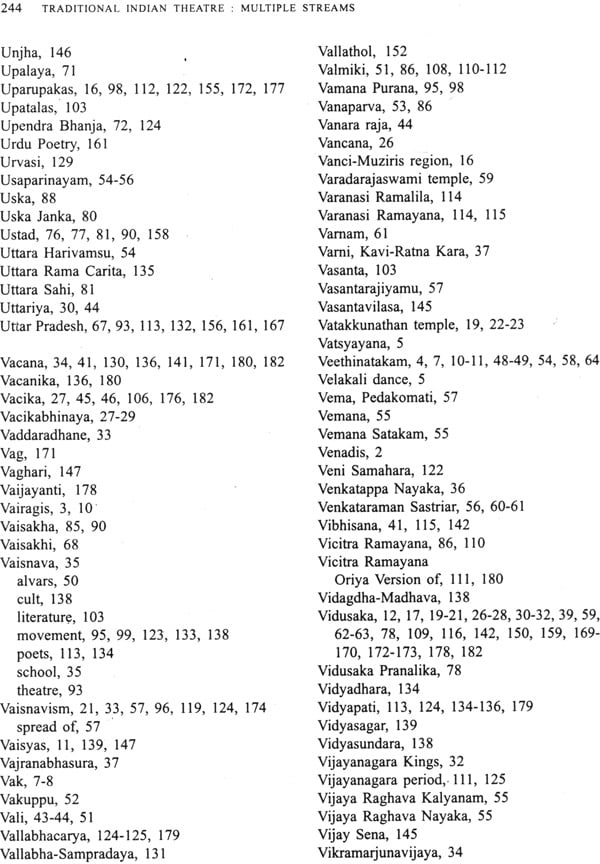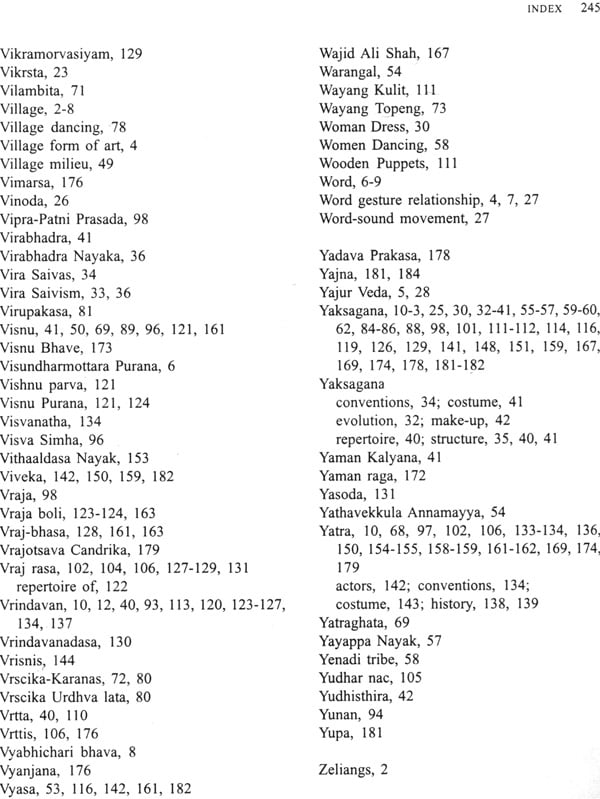
Traditional Indian Theatre: Multiple Streams
Book Specification
| Item Code: | IDE959 |
| Author: | Kapila Vatsyayan |
| Publisher: | National Book Trust, India |
| Language: | English |
| Edition: | 2005 |
| ISBN: | 8123744617 |
| Pages: | 258 (Color Illus: 5, B & W Illus: 34) |
| Cover: | Paperback |
| Other Details | 9.5" X 7.3" |
| Weight | 540 gm |
Book Description
From the Jacket :
The book is a pioneering study of some forms of Indian performing arts which are neither "folk" nor "classical" in the conventional sense of the terms, but belong to a twilight region combining elements of both. Though often widely divergent in character and expression, they nevertheless present an organic cohesiveness and a world-view which, typically as well as traditionally, are Indian. It is this unity of experience which adds a special quality to the present work.
The contents include description and analysis of a variety of forms such as Yaksagana, Bhagavatamela, Chau, Nautanki, Ramalila and many others, and cover the whole India, from Kerala to Uttar Pradesh, from Gujarat to Assam. While presenting them in a desired perspective, the author has not only used evidence from archaeological, textual and oral sources; whatever she says is also the result of a knowledge and comprehension which can be expected only from an artist. An 'Afterword' by the author for the present edition has been added.
About the Author :
Dr. Kapila Vatsyayan, a classical dancer in her own right, is also one of the eminent theoretical exponents of Indian dance forms. She has been engaged in a systematic study of the performing arts for twenty-five years and among her widely acclaimed publications are Classical Indian Dance in Literature and the Arts and Traditions of Indian Folk Dance. She is a Fellow of the Sangeet Natak Akademi and a recipient of the Jawaharlal Nehru Memorial Fellowship.
My first book entitled Classical Indian Dance in Literature and the Arts traced the history of the Indian performing arts in their framework of interrelationship until the 11th century. A second volume entitled Traditions of Indian Folk Dance followed. It sought to present a contemporary spatial picture of the living traditions at the tribal and rural levels. The large grey area comprehending nearly a thousand years of Indian history between the 10th and the 19th centuries and covering all parts of India remained untouched. For any meaningful framework it was necessary to bridge this gap. The task was challenging both on account of the evolution of regional languages and literatures, as also for the staggering multiplicity of genres and styles of the visual and performing arts. The unity provided by the Sanskrit language and a pan-Indian tradition appears to give place to an amazing plurality of traditions often mistaken for fragmentation and heterogeneity. Nevertheless a perusal of both medieval literature and examination of the living survivals of the several forms made it obligatory to explore this phenomenon; specially because the period has often been dismissed as the proverbial Dark Ages of the Indian performing and visual arts. Such a task could appropriately be accomplished adequately only as a teamwork project.
Despite the obvious limitations of a single individual attempting it, I felt that it was necessary to provide at least rough framework in spatial and temporal terms so that the contours of growth and the underlying unity of these seemingly diverse forms could be identified. The book would not of course have been written but for the persuasive request of some friends. As I began to explore the area I was convinced that 'theatre' in its totality rather than just 'dance' or 'music' which has been my chief concern was the true indicator of the period under discussion. Here the spoken and sung word and the 'movement' could not be dissociated from each other. It would be almost impossible to see these elements in isolation. Theatre was a total experience and multimedia expression comprehending the four types of abhinaya and the two levels of presentation, namely the Natya and Loka. Also the prolific literary activity of medieval India convinced me that the origins of the so called folk rural forms lay as much in regional literatures as in the oral traditions. This deduction was further confirmed through an in depth study of the oral traditions. It was further con finned through an in depth experience of the contemporary survivals of the theatre forms so far loosely termed as 'traditional' or 'folk drama'. Both literary evidence and personal discussions revealed that the literate and the oral traditions should be seen in a framework of relationship rather than of dissociation. What appeared on the surface as belonging only to the rural masses without history and ancient links indeed embodied elements which were the continuation of tradition of the Natyasdstra. Questioning of some accepted hypothesis of the Indian artistic traditions became obligatory. First, whether the Natyasdstra system itself did not incorporate regional and local styles and second, whether or not the plural traditions were in fact multiple flowerings of the same tree. The result is the present volume. Its main aim is to trace the roots of these forms and the gradual development of these genres.
The contemporary manifestation has been placed against the backdrop of the literary and artistic history of the region.
Naturally, such a presentation can only be a starting point of further intensive individual studies of each form at the micro-level. The aim of the present study is to provide the basis of such a fuller reconstruction of each form and genre.
Understandably even a first attempt demands traversing of several regional literatures, plural miniature painting traditions and the other allied arts. Few can hope to master all Indian languages in a lifetime or have access to original sources. Despite my fortuitous circumstance of being able to follow half a dozen or more Indian languages, the limitation is fully recognized. Necessarily translations and secondary sources had to be relied upon, with the full recognition of the obvious limitations.
Besides, chronology of regional languages and literatures continues to be a matter of controversy. Dates remain an area of heated debate and dispute. In the case of some literatures, even dates of major landmarks, such as Kamban, remain unresolved. In such a situation where the primary purpose is not to establish chronologies and speculate on authentic dating but to follow the general contours of literary development, one could do no better than to rely on the chronologies suggested by critics and authors of the languages. The Sahitya Akademi series of Histories of Telugu, Kannada, Malayalam, Bengali and Oriya have been helpful in this regard. I acknowledge sincere debt to the authors of these histories, as also to Sri K.M. Munshi and Sri M.R. Mazumdar in respect of Gujarati. For the historical account of Bhaona and related forms I am indebted to Dr. Maheshwar Neog and Sri H. Barua. Dr. Maheshwar Neog also provided the opportunity for many stimulating discussions on the arts of Assam. For the detailed accounts of Khyala, etc. Dr. Mahendra Bhanwat's work has provided rich material.
But theatre is an occurrent experiential art unrestricted to the written word. The experience and the discussion are indispensable. In this, I am grateful to scholars and savants in different regions of India. Foremost amongst these is the late Dr. V Raghavan. It was at his insistance and persuasion that I took the first journey to Melattur as far back as 1949. He first introduced me also to Kutiyattarn, Yaksagana and Bhagavatamela. To him I owe a debt which cannot be articulated in words. Also I remember Sri E. Krishna Iyer's cooperation. Discussions with Prof. K. S. Karanth, Dr. Martha Ashton and Bhagavatar Gopal on Yaksagana have been most enlightening and rewarding. The several masters of Kutiyattam including Mani Madhava Cakayar and Ram Cakayar answered many queries. Kunnjuni Rajas' monograph and Clifford Jones and Betty Jones' work on Kutiyattam have provided fresh insights. The most rewarding experience has been the stay in Kerala where I could satiate myself with these performances night after night.
Although literary material on the Chau forms is scanty, I have been fortunate in discussing many aspects of the forms with both the scholars and artists of the three forms. I should particularly like to thank Sri Krsna Cand Naik and others for Mayurbhanj Chau, Guru Kedarnath Sahu and Raja Brijendra Singh Deo for Seraikala and Sri Asutosh Bhattacharya, Smt. Purnima Sinha and Guru Gambhir Singh for Purulia.
Repeated trips to Mathura and Vrundavan and discussions with Swami Ladli Prasad, Ramsvarup and Hargovinda enriched my understanding of the Lila forms. I am indebted to them. The work of Sri Ramanarayana Agrawala and Sri Yamadagni has been helpful in rechecking defects of contemporary performance. Prof. Dashrath Ojha's work in Rasa along with that of the late Sri J.C. Mathur's, specially their joint publication Prdcina Bhdsa Nataka, have provided valuable material for reconstructing the history of some of the forms. Prof. Dashrath Ojha has generously provided information and material. Indeed some of it I have not been able to incorporate in the study.
Besides the woks of Sri K.M. Munshi and Sri Mazumdar, stimulating discussions with Smt. Sudha Desai and Sri Rasikalal Parikh clarified many doubts in respect of Bhavai. Sri Mansukh Joshi and others from Gujarat have generously responded to queries. It was however after the manuscript was sent to the press, that I had the real exhilarating experience of Bhavai at a festival held in Morvi, recently. After discussion with the Bhavayas, particularly Sri Manibhai and Sri Babubhai, and specially after I had a chance to witness their electrifying performance, I would gladly modify some of my observations on Bhavai which were based on earlier experiences. This latest experience obliges one to add that what I considered a languishing albeit crude survival of a five hundred year old theatrical form is in fact a vibrant tradition with a fantastic range and polyvalence of content, language, stage techniques and musical modes. To these masters I acknowl- edge my sincerest debts. This was a deep experience of learning.
Although Yatra today has achieved a new high in commercial theatre, there have been occasions for witnessing authentic and genuine performances. Discussions with Prof. Asutosh Bhattacharya and Smt. Sova Sen have also been helpful.
Dr. Mahendra Bhanwat's work on Khyala and Sri Devilal Samar's deep and extensive knowledge of the Rajasthan arts have always been useful. They have both provided occasions for witnessing performances and subsequent discussions. To them I am grateful. Although much has been written on the Tamasa in Marathi, the roots of which have been traced only to the oral traditions. Further probing into Marathi literature has led me to speculate on the literary sources of this popular form of theatre.
Despite my best intentions, it was not possible to include here many other forms, particularly Kariyala from Himachal Pradesh and Bhafid Pather from Kashmir. Sri S.S. Thakur's monograph on the former scheduled to be published by the Sangeet Natak Akademi will undoubtedly fill this gap.
I am indebted also to the writers of all previous studies on the subject or particular forms especially Dr. V. Raghavan, Sri Suresh Awasthi and Smt. Induja Awasthi, Mr. Clifford Jones, Sri Kunnjuni Raja, Dr. K.S. Karanth, Sri Balwant Gargi, late Sri J.C. Mathur and Dr. Shyam Parmar. The late Dr. V. Raghavan, Dr. Shyam Parmar and Sri J.c. Mathur were poineers in the field and their absence will be long felt. It is a pity that we shall no longer be receivers of future contributions by these discerning scholars.
It was not altogether easy to collect or select photographs for the publication. In this sphere many institutions and individuals have been most cooperative. Mr. Clifford Jones readily provided excellent documentation for Kutiyattam, Sri Balwant Gargi on Yaksagana and other forms through Nibha Joshi of the National School of Drama. The Sangeet Natak Akademi's collections of photographs have been a helpful source. Thanks are also due to Haridas Bhatt of the Yaksagana Kendra Udipi, the Bharatiya Loka Kala Mandal, Anamika in Calcutta, Smt. Sova Sen, the Rangsri Little Ballet Troupe, the Indian National Theatre, the Government of Assam Publication Division, Prof. Asutosh Bhattacharya and many others.
To Sri Balu Rao of the Sahitya Akademi, I owe thanks for perusing the chapters on Kutiyattam, Yaksagana and Bhagavatamela and for offering many helpful suggestions.
Dr. Lokenath Bhattacharya spared valuable time to edit a manuscript which presented many problems of transliterations, uniformity in English renderings, the maintenance of an easily readable style for an Indian lay reader. In all these matters he was extraordinarily helpful. Smt. Varsha Das has competently seen the book through the press. To them and others of the National Book Trust I am grateful. Sri S. Sharma typed the difficult manuscript and thanks are due to him.
And finally to Dr. S. Gopal, former Chairman of the National Book Trust, at whose active initiative the manuscript was begun.
Even at the cost of repetition it is necessary to say that this must be considered as a rough framework for further intensive and in depth studies of the several genres and multiple streams. The attempt here has been to see these multiple traditions in their essential framework of mutual relationships of some unifying principles, themes, content and many distinctive formal elements. It has also been my endeavour to raise some conceptual issues on the nature of interaction which takes place between different levels of manifestation, and to link the textual sources, both creative and critical, with the living contemporary traditions. If this can stimulate thought and arouse some interest in seeing the multifaceted vibrant traditions of Indian theatre both for their intrinsic value and as important indicators of the Indian cultural traditions, my task is accomplished. Further reading has been suggested for those 'who wish to probe deeper: the present work is by purpose written for the lay adult Indian reader in keeping with the objectives of the National Book Trust. Between the writing of the book and the publication there is a gap of four years; valuable material on the subject has appeared in the intervening period, which has been incorporated in the bibliography.
And lastly I acknowledge my grateful thanks to the Jawaharlal Nehru Memorial Foundation which gave me the opportunity to complete the manuscript. Much of the material was gathered over many years, but a part of it was also related to my study on the Gita-Govinda and the Indian Artistic Traditions. In one sense this is an extension or a by-product of that study. The space and time framework of the two studies coincided, and the queries of one helped to support and reconfirm deductions on the other. Other data gathered in the course of the study of the Gita-Govinda will be incorporated in a subsequent volume which will be devoted specifically to the Gita-Govinda and the performing arts traditions of India between the 13th and 19th centuries.
A mention of the performing arts of India immediately brings to one's mind the single- bodied and many-armed image of Durga, osr of Siva in his form as Nataraja, ever destroying, ever creating new forms of the dance Tandava. These symbols in plastic form suggest at one level the unified equilibrium, the still-centre, and at the other, the continual play of 'energy' and rhythm in plural forms. The two aspects are interconnected and mutually dependent. The varied art forms like the multiple arms and hands, though distinct and different, are all limbs of the same body. The seeming heterogenity and multiplicity of the several forms may be compared to the different modes of the Tandava.
Understandably, it is impossible to speak of one monolithic tradition of the arts, particularly of the performing arts in India, which depends and at the same time do not depend on verbal communication only.
There are traditions, and not one tradition, of the performing arts in the vast geographical area. All are characterised by a staggering multiplicity of genres, forms, styles and techniques. Even the contemporary scene belies all classification in terms of clearly defined categories of Western performing arts into classical and folk, sophisticated self-conscious individual artistic creation and collective participative activity, into spoken drama based on the word, musical note or gestures or movement. Nor can they be classified into neat categories of the opera, operetta, the symphony or the chamber orchestra. Further, the insulation of different categories from one another, so characteristic of Western forms until the twentieth century, has been absent here from time immemorial.
Nevertheless, in spite of these complexities and an apparently eternal timelessness, a close look reveals that each of these traditions as prevalent in different regions of the sub-continent and at different levels of society, can be clearly identified both in terms of the evolution of artistic form and style in time and its socio-cultural milieu in space. Layers of different moments of time can be identified in a seemingly contemporary form. Establishing, thus, a chronology of the cultural pattern, within which traditions of the performing arts flourished, becomes a highly abstract approach, an abstraction which on one hand guides the spirit of these forms, providing the fundamental unity or continuity and a sense of timelessness, and on the other is marked by an equal preoccupation with multiple, concrete and varied forms and 'time present' which accounts for change and a continual flux.
Although it would be hazardous and difficult to provide an explanation for this apparent paradox of simultaneous static equilibrium and change and dynamism, it may be worthwhile to try to identify the underlying principles of 'commonality' or universality of cultural traditions of Asia, particularly of the performing arts of Asia, with special reference to India. In order to arrive at some conceptual hypothesis it would be necessary to mention briefly the spatial and temporal situation of these arts.
The spatial situation can be seen both in terms of levels of society and the nature of performance. It can also be seen in terms of the geographical distribution of the different racial/ethnic and linguistic groups.
In purely anthropological terms the levels naturally are tribal, village and urban; in artistic terminology they are sometimes called 'folk' and 'classical', the first implies community participation and the second refers spontaneously to systemized methods of expression- which imply community. Although never explicitly stated, 'folk' is correlated to tribal/village and 'classical' to the urban sophisticated, whether industrialised or not. These implied correlatives have been the cause of much misunderstanding regarding the Asian or the Indian arts. We shall presently examine the nature of such misunderstandings.
Nevertheless, let us begin with a brief account of the different layers of social structure which can be clearly identified in practically all regions of India.
A pervasive tribal belt passes through all parts of India: the dances of these tribal groups can be classified on the basis of anthropological, ethnical factors. Nearly thirty- eight million people of India belong to this category: their dance and music are examples of vigorous folk and classical styles.
There is the Himalayan belt extending from Kashmir to Himachal Pradesh and continuing further to the eastern hills of Bhutan, Sikkim, Manipur, Assam, and Mizoram. Those inhabiting this vast region include distinct tribal communities ranging from the Gujjars to the Bakarwals, and finally ending with the many tribal groups known generally as the Nagas. Chief among these are the Zeliangs, the Maos, the Tang Khuls, the Daflas, the Semas and the Aos.
Another tribal belt can be discerned at the foothills of the Himalayas and merging into the great plains encompassed by the rivers Yamuna and Ganga. Among the tribals of the foothills and great plateaus are several which can be grouped together on account of their social structuring of their life-styles. Again, subgroupings are possible. The tribes of the deserts and plateaus of Rajasthan, Gujarat and Maharashtra form one macro group, while the Oraons, the Has, the Marias and the Santhals and some tribes of Orissa constitute another. There are then the tribes which inhabit the plateaus and sea-shores south of the Vindhyas. Among these tribes are some of the most ancient ones, such as the Todas, the Banjaras, the Venadis, etc.
An analysis of the music and dance of these nearly thirty-eight million people shows that these tribes make little or no distinction between verbal and nonverbal communication systems and techniques. Expression is total. Individually, this expression may be free, but in groups it is mostly a conditioned movement or sound directly related to life function and experience, such as the hunt, etc. Also the song or the dance is a participative activity, but not spontaneous in the sense of allowing free movement. Like the tribal society, the artistic too are highly structured.
. Next comes the stage of food-gathering, with a variety of magical fertility rites. Here the immediacy of life experiences is recalled in sound, rhythm and movement. Dramatic action makes its appearance for the first time; naturally, the spoken word and gestures assume a definite position. The fertility rites connected with the earth, the sun, and the moon play an important part here. The artistic form is conditioned not so much by the structuring of the tribal society as in the Daflas, the Aos, the Marias, the Hos and the Oraons, but rather by the functions of the rite: all the pole dances of India belong to this category. The beginnings of procession, music and dance can be traced back to the rites of the 'Jhum' cultivators.
There is then the organized village society whose origin can be linked with the Vedic concept of grama. Nearly 75% of the population of this country and perhaps of some other parts of Asia have lived and continue to live within this social structure. These villages have been analysed from many points of view, both historical and sociological. Here music, dance and drama have been woven into agricultural functions and are integral to the daily and annual routines of the peasant. Many survivals and continuities of tribal society can be discerned in the agricultural rites connected with sowing, reaping, and harvesting. The origin of these, along with many dances of propitiation of magic and sorcery, goes back to an unknown antiquity. Thus, often a contemporary community dance contains in it elements of the original tribal life function. The Garba and the Bhangra are typical instances.
Co-existent with the manifestations which are integral to the agricultural cycle of the life of the peasant are artistic manifestations based on the two epics and the many Jatakas and Puranas of Buddhist, Jaina and Hindu origin. In many parts of Asia these epics and Jatakas, often local and indigenous myths based on them and similar legends of the oral traditions, continue to playa vital role. The many pageants and tableaux and local forms of dances and dance-dramas developed from both the pure recitative word and its consequential interpretation through gestures, mime and song. The local variations of the epics have been considered as the permeation of the 'great' tradition to the 'little'. However, it is often forgotten that these local and regional forms in turn shaped many literary versions of the epics. A history of the development of the Rama theme will make this amply clear.
Close to the village community but a class apart is a group of professional singers, dancers, musicians and actors, who are differently classified all over India as Bhadas, Nats, Gandharvas, Vairagis, Binkaras etc. This is a group for whom the performance is a vocation, not a social, tribal or agricultural function. They are in and yet out of society, a community or group recognized since the days of Panini. They move from place to place. It is this group of people which has been responsible for the mobility of ideas, forms and styles between the villages and urban centres. They have also been the vehicles of expressions of protest, dissent and reform, the carriers of reform movements and the articulators of satire and social comment .and thus the instruments of socio- cultural change. The contemporary forms such as Bhavai, Nautanki, Terukoothu, Veethinatakarn, Ottanthullal, etc., belong to this group. In artistic form, their technique ranges from acrobatic to pure spoken drama. The word-gesture relationship is, however, minimal. Of late, these forms have been termed folk-drama, traditional theatre, even street theatre and folk dance. The essence of these forms ranging from ballad recitation and melodic singing for puppetry, acrobatics, dance and theatre, derives from the social sanction and liberty given to make social comment. It is this which links them together. Our concern in the present study is in the main with this category of performing arts of India.
There is finally the urban, city-based culture, not necessarily modem, which has grown up from the tribal/village culture and has, in turn, affected it. Forms which developed within the framework of agricultural and other life functions and particular social organizations are carried forward and taken over in an urban milieu, though only after they have been dissociated from their original agricultural functions. There is no longer an integral relationship with the rigorous social structuring. Into the old form is now introduced a new literary content and a musical score. Classicity is the result. A mannerism and stylization are achieved through chiselling of the earlier forms and structuring them in relation to word and sound. This then has been the secret of the highly esoteric arts which have not lost their links with the earth and have in them the potential of continued rejuvenation through successive ages.
At this level the same, the Puranas and the themes receive a different treatment. The performers are professional or non-professional in terms of economic vocation but they are all dedicated academicians committed to the arts as a discipline of life and as a means of release.
This multi-layered pattern can be observed in practically every region of India; it can also be discerned in many parts of Asia, particularly, Java, Bali, some parts of Thailand, and Burma.
Can one postulate and sum up from this descriptive survey? It is perhaps hazardous but worthwhile. Roughly it may be stated thus. The arts developed in a framework of a local or regional distinctiveness which cuts across socio-economic stratification. There is a dialogue and interaction between varying levels and often there is much overlapping. The movement is a two-way traffic and not merely the penetration of 'great art' into popular levels. Tribal and village forms also affected and continue to affect 'high art'. Also, there is a clearly identifiable pattern of communication among regions at particular levels. Thus, there are two broad patterns: one, a vertical movement among forms of a particular region at different levels and socio-economic groupings, and another, a horizontal movement among regions where themes, content and forms have developed in a framework of continual communication at particular levels.
It could nevertheless be possible to identify contemporary artistic manifestation as tribal, village, semi-urban and urban, and delineate the paths of communication and interaction among them in different regions and within a region, between tribal village and sophisticated forms. Merely as illustration, one may draw attention to forms in Orissa, Manipur, Kerala and Madhya Pradesh which provide excellent examples of this cultural phenomenon. There is, for example, a connection between the forms of the tribals of Ganjam district, the Paikas, the dancers of Mayurbhanj, the Jatra players and the Gotipuas of the Akharas and the Maharis of the temples in Orissa. Channels of communication between the Kali, the Pulyara Kali, Velakali dances and those of the Devi cult, the Theyattam, Theriyattam and finally Kutiyattam and Kathakali can also be discerned. Alongside are the elements of commonality and universality among sophisticated forms of dance, such as Odissi, Bharatnatyam, Kathak and Manipuri belonging to different regions of India.
This spatial situation has to be supplemented with a historical temporal perspective where we see that the traditions of the performing and plastic arts developed within a framework of interconnection and interdependence as a self-conscious awareness arid principle and not as mere chance. While the Mohenjadaro civilization was urban, the Rgvedic society was pastoral and nomadic with many in-built systems of social cohesiveness and mobility. The Saman was the meeting place of all. By the time of the Yajurveda, the magic ritual gestures and the symbolic use of the body had assumed importance. The Atharvaveda lays the foundation of a highly developed symbolism and a system of correlation between sense-perception and its expression and meaning: this permeates through all levels of Indian art normally termed as magical, ritualistic and esoteric. In the Samaveda, the concept of the margi and desi tells us of the acceptance of levels. After the Vedic, both the upanisadic speculative thought and the Brahmanical ritual traditions gave rise to two parallel streams viz: a unified abstraction of spirit and a simultaneous symbolic concretization in form.
In aesthetics, this framework of the arts was recognized and articulated by the mythical Indian theoretician, Bharata, as early as 2nd century B.C.- 2nd century A.D. He conceived of the theatrical spectacle as a total amalgam of all media and genres ranging from the spoken word to vocal and instrumental music, gestures, mime, decor, costumes, and finally, the inner states of being. He recognized the two levels of performance in the concept of naturalistic (loka, real) and stylized conventions (natya) of the stage. He saw style as a mode of presentation ranging from the grand to the verbal, from the lyrical to the introspective. He also recognized the emergence of the regional variants in the concept of the paravrttis.
| Preface and Acknowledgements | ix | |
| 1. | Introduction | 1 |
| 2. | Kutiyattam | 15 |
| 3. | Yaksagana | 32 |
| 4. | Bhagavatamela and Kucipudi | 48 |
| 5. | Chau | 65 |
| 6. | Mayurbhanj Chau | 75 |
| 7. | Purulia Chau | 82 |
| 8. | Ankia - Nata and Bhaona | 93 |
| 9. | Ramayana and Ramalila | 108 |
| 10. | Raslila and Krsnalila | 119 |
| 11. | Yatra | 133 |
| 12. | Bhavai | 144 |
| 13. | Svanga, Khyala, Nautanki | 155 |
| 14. | Tamasa | 166 |
| 15. | Conclusion | 174 |
| Afterword | 185 | |
| Appendices | 195 | |
| Select Bibliography | 199 | |
| Glossary | 207 | |
| Index | 219 |

